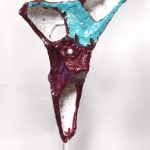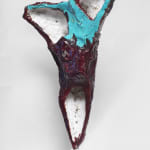


LEONCILLO LEONARDI
Corpo dolente, 1952
Glazed polychrome ceramic
88 x 59 x 26 cm (dimensions without base)
Further images
Provenance
Private collection.
Exhibitions
Maestri del '900 - Cinquant'anni di presenza a Corciano, curated by Alessandra Migliorati, 8 August - 6 September 2015, Chiesa Museo di San Francesco, Corciano, Perugia;
Le ceramiche di Rometti, curated by Enrico Mascelloni and Mariella Caputo, 25 June - 6 November 2005, Rocca di Umbertide. Centre for Contemporary Art, Umbertide, Perugia.
Literature
Maestri del '900 - Cinquant'anni di presenza a Corciano, (exhibition catalogue) edited by Alessandra Migliorati, 8 August - 6 September 2015, Chiesa Museo di San Francesco, Corciano, Perugia, Fabrizio.
Leoncillo Leonardi, better known simply as Leoncillo, is recognised for his significant contribution to 20th-century sculpture. His work is characterised by a profound exploration of human emotions through an innovative use of ceramics, which he transformed into a powerful and dramatic means of expression. His artistic training began at the Academy of Fine Arts in Perugia and continued at the Academy of Fine Arts in Rome, where he studied under the guidance of such masters as Arturo Martini.
His sculptures are distinguished by a strong emotional charge and a bold use of the ceramic material, which often appears as if it were on the point of exploding or melting. Leoncillo developed a unique style which blended expressionist and abstract influences, to create works which often reflect human torment and suffering. Lacerations, tears, fractures, wounds, and incisions in the material were not only ways to work the clay, but also to convey intimate impulses in shapeless masses which recall organic and vegetable agglomerates, mutilations, pierced Saint Sebastians, bodies in pain.
Corpo dolente is considered one of Leoncillo’s most emblematic and powerful works. This sculpture highlights his ability to convey intense emotions through abstract shapes and the distinctive way he manipulated the material. Created in 1952, shortly before his “Informal Period”, Corpo dolente embodies human pain and suffering, elements which Leoncillo was able to express with extraordinary visual force. The surface of the sculpture seems almost on the verge of disintegrating, reflecting both the precariousness of existence and inner torment. The choice of colours and the material texture suggest an internal struggle, a conflict between hope and despair, between strength and vulnerability.
This sculpture, evocative of a crucifix transfigured in an abstract vein, emerges as a work of intense expressiveness and bold formal experimentation. The broken lines and distorted volumes seem to encapsulate a dramatic energy, transforming the traditional figure of the crucifix into a dynamic and fragmented composition. The irregular surfaces of the ceramic give the sculpture a palpable texture. In this modern reinterpretation, Leoncillo captures the very essence of pain and redemption, transcending a figurative representation to explore new expressive dimensions. The meaning of the work goes well beyond a simple representation of physical pain; it is a meditation on existential suffering and the universal human experience of pain. Leoncillo invites the observer to confront these deep emotions, to reflect on his or her own human condition and the fragility of existence.

Leoncillo Leonardi, Crucifix (19), Polychrome terracotta, 27 x 19 cm
This sculpture is characterized by the use of three main colours: blue, white and amaranth. Blue, habitually associated with feelings of melancholy and introspection, dominates the central part of the work, creating a sense of emotional depth. The white within the sculpture, with its connotations of purity and vulnerability, transects the blue, while amaranth, an intense and passionate colour, adds a dimension of drama and suffering. The interplay of these colours not only defines the forms of the sculpture, but amplifies the work’s emotional message.
Join the mailing list
Subscribe to our newsletter to receive all the news about exhibitions, fairs and new acquisitions!


